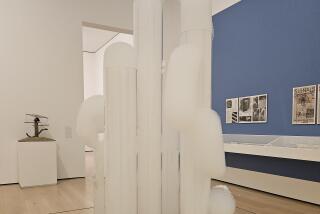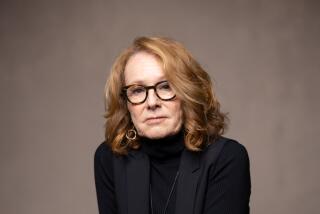‘Sexual Politics’ an Important Show
Christopher Knight’s review of the UCLA/Armand Hammer Museum’s landmark “Sexual Politics” exhibition and his ad hominem attack on the show’s curator, Amelia Jones, must surely be one of the oddest journalistic events of the season, given the near-universal astonishment the review has spawned both on the Internet and in some feminist and more general art historical circles just this past week (“More Famine Than Feast,” Calendar, May 2).
The reviewer got one thing right in stating that feminism has been possibly the most influential and momentous social movement of the last three decades, its principles integral to contemporary art and culture. But Knight’s observations cause this writer to wonder whether he had attended the same show as the rest of us.
The show’s programmatic (and perfectly obvious) critique of the patriarchal ideologies of “art-for-art’s-sake”--this is, after all, a critical history of feminist art practices--seems to get the reviewer’s goat. “ ‘Sexual Politics’ [he writes] isn’t really about art at all. Instead, it’s a history of contemporary feminist theory . . . works of art have been deployed as mere illustrations [of] feminist argument. . . . “ Even a passing familiarity with the history of art should lead to an appreciation that artistic practices of the last 200 years have never been separate from critical and theoretical discourse and debate. Knight would have us believe that the (young female) curator, in organizing an exhibition that is historically, aesthetically and critically responsible is therefore an “ideologist” who “misuses” and “trivializes” art.
Feminist artists, scholars and critics have been familiar with this kind of scolding, patriarchal double-speak and with its condescending rhetoric for a long time. But you don’t need to be any kind of feminist to be aware that the real target of Knight’s umbrage is one section of the show, Judy Chicago’s “Dinner Party” of 1974-79, made in Los Angeles but never before shown here. Knight does not target the Hammer’s director, Henry Hopkins, for bringing the piece to Los Angeles (Hopkins was responsible for the original debut of the work in San Francisco in 1979 when he was curator of a local museum there).
Knight persistently says he dislikes the piece. The sheer flood of invective remains puzzling: Whether one “likes” Chicago’s work or not, its reconstitution here, in the context of the first substantive exhibition to chronicle the central role played by Los Angeles in the birth and growth of the American feminist art movement, is an important event.
Judging from the volume of visitors to the show, it’s gaining the wide attention it deserves from a very diverse cross-section of the community. That it deals with works that demand thought and attention because of their direct engagement with fundamental questions of identity, gender, ethnicity, race and sexuality is a breath of fresh air. Jones and the Hammer are to be congratulated for mounting a critically and historically important exhibition.
More to Read
The biggest entertainment stories
Get our big stories about Hollywood, film, television, music, arts, culture and more right in your inbox as soon as they publish.
You may occasionally receive promotional content from the Los Angeles Times.










